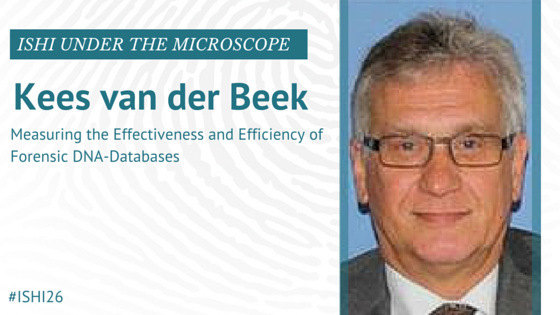The ISHI 26 agenda is already filling up with some great talks from amazing speakers! While the forensic community is a tight-knit group, we can always get a little closer, right? With that in mind, we asked our speakers some questions to get to know them a little better outside of their work. We’ll be posting their responses over the coming months in a feature we like to call Under the Microscope.
Today, we’re chatting with Kees van der Beek, who will be presenting Measuring the Effectiveness and Efficiency of Forensic DNA-Databases during the General Sessions.
Dr. Kees van der Beek MBA was hired by the Netherlands Forensic Institute (NFI) as a project manager in 1999 to help expand the capacity of the DNA department and also develop a DNA-based process for the Dutch Immigration Authorities to verify family relationships. Later on he was asked to become the deputy head of the DNA-department. Presently he is the custodian of the Dutch DNA database and the national contact point for the exchange of DNA-profiles based on the EU-Prum-Council-Decisions. He is the leading scientist for DNA of the EU-Prum implementation working group (DAPIX). In this role he assists the semi-annually changing chair of this group and the European Commission. He also directs the annual update of the ENFSI DNA Working Group document on DNA-database management and the semi-annual ENFSI overview of the contents and the results of DNA-databases in Europe.
How did you come to work in the field of forensics/DNA?
I was hired by the Netherlands Forensic Institute (NFI) as a project manager in 1999 to help the NFI to expand the capacity of the DNA department and also to develop a DNA-based process for the Dutch Immigration Authorities to verify family relationships.
If you woke up tomorrow and this field no longer existed, what would you choose for a career?
I would retire (I will become 64 a few days after the conference).
What new technologies are you most excited about or where do you see the field heading in the next 10 years?
Massive Parallel Sequencing and Rapid DNA Testing
What was the most challenging or bizarre case that you’ve worked on?
The identification of a suspect of a murder and rape case from 1999 in 2012 by means of a Y-chromosomal mass screen of over 8000 men after the failure of a familial search in the Dutch DNA-database which yielded many possible family members which were all eliminated as false positives by means of additional autosomal, Y-chromosomal and mitochondrial DNA-testing.
What person would you say has had the biggest influence in your life?
My wife
Can you think of a specific example where ISHI has helped you in your career or with a case?
At ISHI 2010 I spoke about Forensic DNA-profiles crossing borders in Europe. I received and still receive many positive reactions with regards to this presentation and its publication.
Who in the audience would benefit most from your talk?
DNA-database managers and policy makers who are responsible for the funding of DNA-databases.
WOULD YOU LIKE TO SEE MORE ARTICLES LIKE THIS? SUBSCRIBE TO THE ISHI BLOG BELOW!


